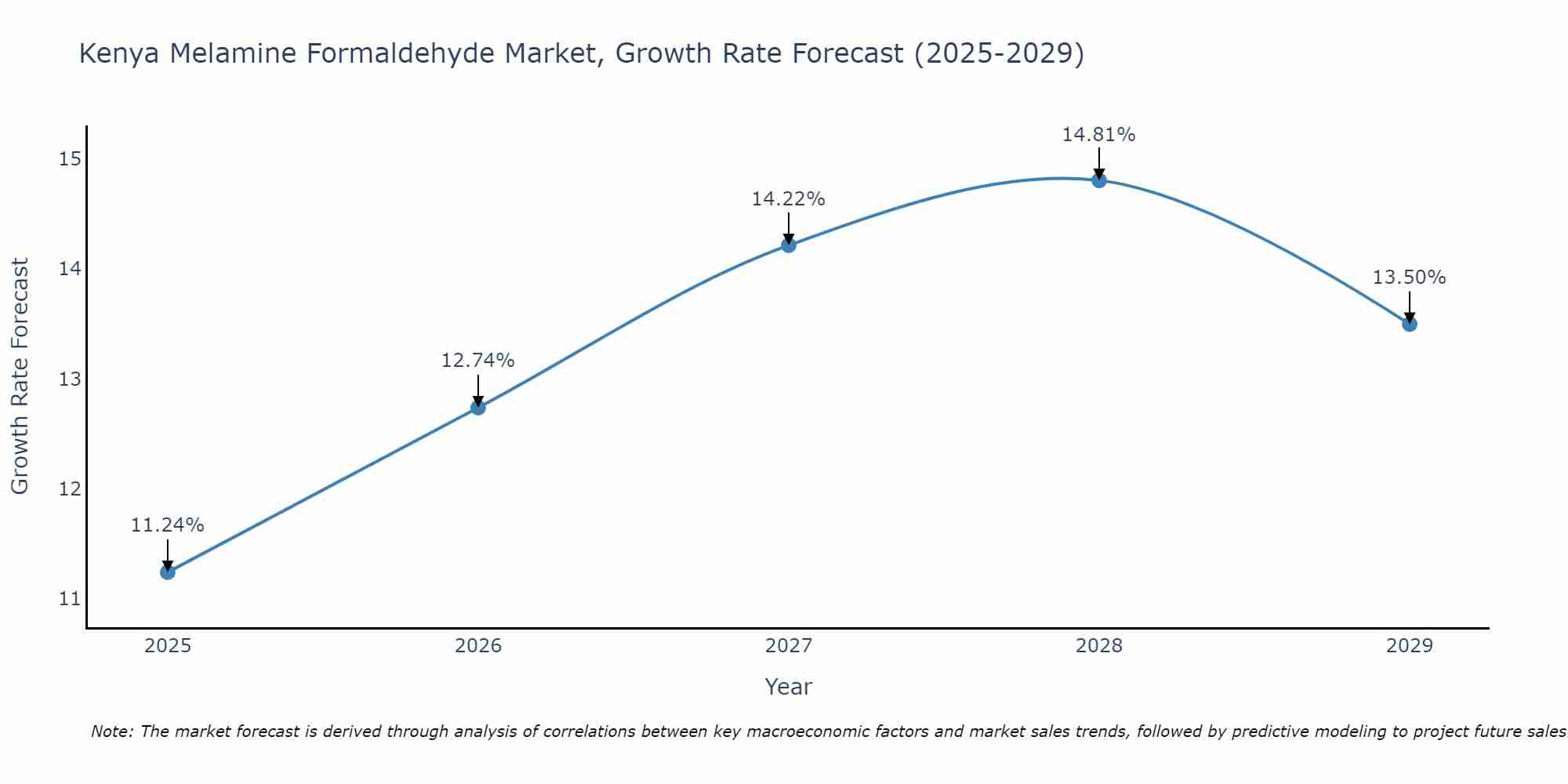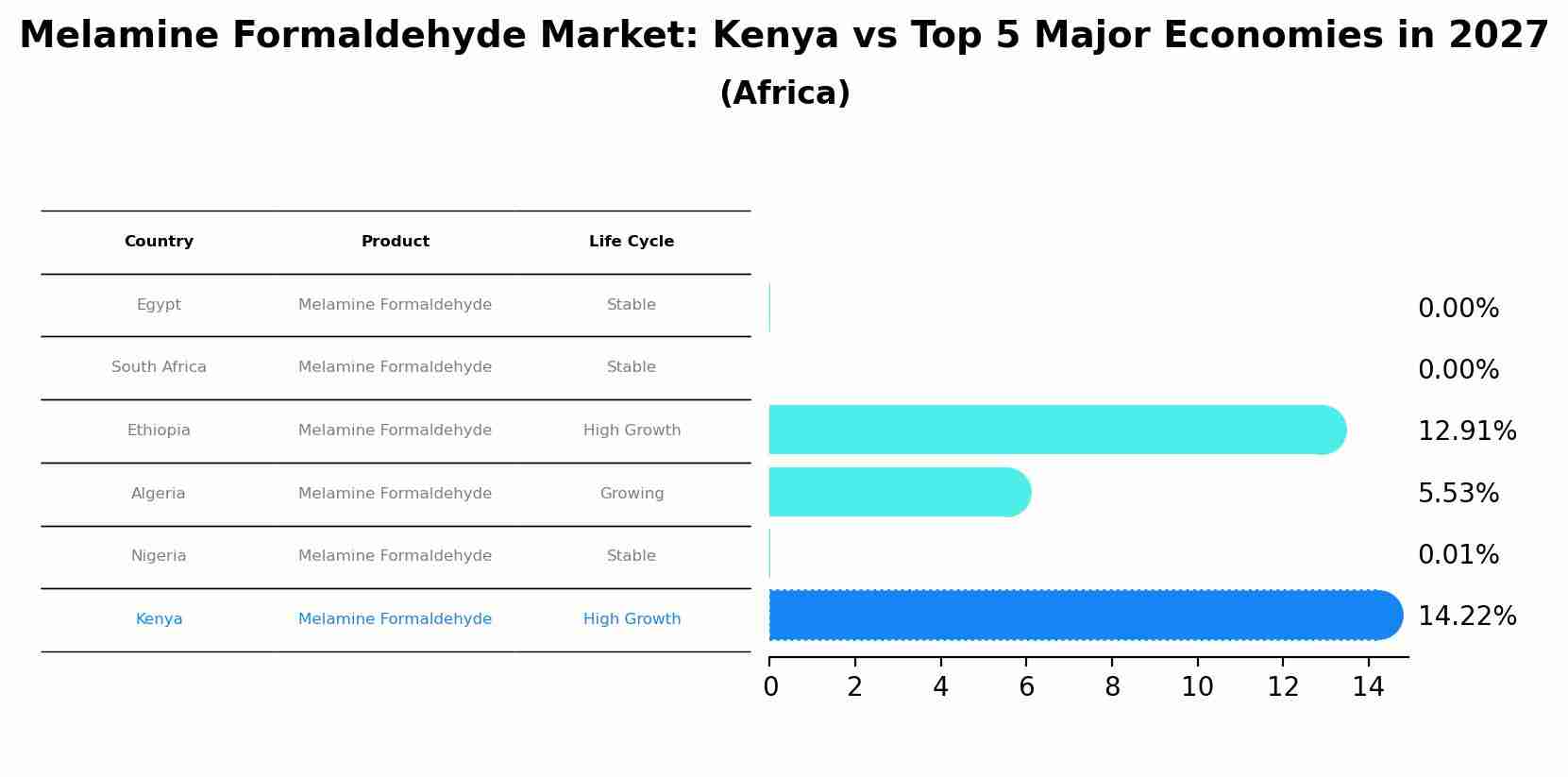Kenya Melamine Formaldehyde Market Outlook | Forecast, Industry, Share, Size, Growth, Value, Revenue, COVID-19 IMPACT, Companies, Analysis & Trends
| Product Code: ETC110169 | Publication Date: Jun 2021 | Updated Date: Apr 2025 | Product Type: Report | |
| Publisher: 6Wresearch | No. of Pages: 70 | No. of Figures: 35 | No. of Tables: 5 | |
Kenya Melamine Formaldehyde Market Size Growth Rate
The Kenya Melamine Formaldehyde Market is projected to witness mixed growth rate patterns during 2025 to 2029. Growth accelerates to 14.81% in 2028, following an initial rate of 11.24%, before easing to 13.50% at the end of the period.

Melamine Formaldehyde Market: Kenya vs Top 5 Major Economies in 2027 (Africa)
In the Africa region, the Melamine Formaldehyde market in Kenya is projected to expand at a high growth rate of 14.22% by 2027. The largest economy is Egypt, followed by South Africa, Ethiopia, Algeria and Nigeria.

Kenya Melamine Formaldehyde Market Overview
The melamine formaldehyde market in Kenya is driven by the construction and automotive industries, where melamine formaldehyde resins find extensive applications. With the construction sector witnessing robust growth and increasing demand for durable and cost-effective materials, the market for melamine formaldehyde is poised for steady expansion.
Drivers of the market
The melamine formaldehyde market in Kenya is driven by its applications in construction materials, laminates, and household products, as well as the demand for durable and moisture-resistant materials in furniture, kitchenware, and decorative surfaces.
Challenges of the market
Challenges in the Melamine Formaldehyde Market include the high cost of raw materials and the complexities associated with production processes. There is significant competition from alternative materials and international suppliers, which affects pricing and market share. Regulatory compliance with environmental and safety standards adds to the operational burden. The market requires substantial investment in research and development to improve production efficiency and develop new applications for melamine formaldehyde. Additionally, there is a need for increased awareness and education among potential users about the benefits and applications of melamine formaldehyde in various industries.
Government Policy of the market
The Kenya melamine formaldehyde market faces challenges related to product safety and environmental sustainability. Market players encounter difficulties in addressing concerns about formaldehyde emissions from melamine-based products and ensuring compliance with health and safety regulations. Additionally, managing waste disposal and promoting eco-friendly alternatives pose hurdles for market expansion.
Key Highlights of the Report:
- Kenya Melamine Formaldehyde Market Outlook
- Market Size of Kenya Melamine Formaldehyde Market, 2020
- Forecast of Kenya Melamine Formaldehyde Market, 2027
- Historical Data and Forecast of Kenya Melamine Formaldehyde Revenues & Volume for the Period 2018 - 2027
- Kenya Melamine Formaldehyde Market Trend Evolution
- Kenya Melamine Formaldehyde Market Drivers and Challenges
- Kenya Melamine Formaldehyde Price Trends
- Kenya Melamine Formaldehyde Porter's Five Forces
- Kenya Melamine Formaldehyde Industry Life Cycle
- Historical Data and Forecast of Kenya Melamine Formaldehyde Market Revenues & Volume By Type for the Period 2018 - 2027
- Historical Data and Forecast of Kenya Melamine Formaldehyde Market Revenues & Volume By Methylated Melamine Formaldehyde Resin for the Period 2018 - 2027
- Historical Data and Forecast of Kenya Melamine Formaldehyde Market Revenues & Volume By Non-methylated Melamine Formaldehyde Resin for the Period 2018 - 2027
- Historical Data and Forecast of Kenya Melamine Formaldehyde Market Revenues & Volume By Application for the Period 2018 - 2027
- Historical Data and Forecast of Kenya Melamine Formaldehyde Market Revenues & Volume By Laminates for the Period 2018 - 2027
- Historical Data and Forecast of Kenya Melamine Formaldehyde Market Revenues & Volume By Wood Adhesives for the Period 2018 - 2027
- Historical Data and Forecast of Kenya Melamine Formaldehyde Market Revenues & Volume By Molding Compounds for the Period 2018 - 2027
- Historical Data and Forecast of Kenya Melamine Formaldehyde Market Revenues & Volume By Paints and Coatings for the Period 2018 - 2027
- Historical Data and Forecast of Kenya Melamine Formaldehyde Market Revenues & Volume By Other Applications for the Period 2018 - 2027
- Kenya Melamine Formaldehyde Import Export Trade Statistics
- Market Opportunity Assessment By Type
- Market Opportunity Assessment By Application
- Kenya Melamine Formaldehyde Top Companies Market Share
- Kenya Melamine Formaldehyde Competitive Benchmarking By Technical and Operational Parameters
- Kenya Melamine Formaldehyde Company Profiles
- Kenya Melamine Formaldehyde Key Strategic Recommendations
Frequently Asked Questions About the Market Study (FAQs):
- Single User License$ 1,995
- Department License$ 2,400
- Site License$ 3,120
- Global License$ 3,795
Search
Related Reports
- ASEAN and Thailand Brain Health Supplements Market (2025-2031) | Strategy, Consumer Insights, Analysis, Investment Trends, Opportunities, Growth, Size, Share, Industry, Revenue, Segments, Value, Segmentation, Supply, Forecast, Restraints, Outlook, Competition, Drivers, Trends, Demand, Pricing Analysis, Competitive, Strategic Insights, Companies, Challenges
- ASEAN Bearings Market (2025-2031) | Strategy, Consumer Insights, Analysis, Investment Trends, Opportunities, Growth, Size, Share, Industry, Revenue, Segments, Value, Segmentation, Supply, Forecast, Restraints, Outlook, Competition, Drivers, Trends, Demand, Pricing Analysis, Competitive, Strategic Insights, Companies, Challenges
- Europe Flooring Market (2025-2031) | Outlook, Share, Industry, Trends, Forecast, Companies, Revenue, Size, Analysis, Growth & Value
- Saudi Arabia Manlift Market (2025-2031) | Outlook, Size, Growth, Trends, Companies, Industry, Revenue, Value, Share, Forecast & Analysis
- Uganda Excavator, Crane, and Wheel Loaders Market (2025-2031) | Strategy, Consumer Insights, Analysis, Investment Trends, Opportunities, Growth, Size, Share, Industry, Revenue, Segments, Value, Segmentation, Supply, Forecast, Restraints, Outlook, Competition, Drivers, Trends, Demand, Pricing Analysis, Competitive, Strategic Insights, Companies, Challenges
- Rwanda Excavator, Crane, and Wheel Loaders Market (2025-2031) | Strategy, Consumer Insights, Analysis, Investment Trends, Opportunities, Growth, Size, Share, Industry, Revenue, Segments, Value, Segmentation, Supply, Forecast, Restraints, Outlook, Competition, Drivers, Trends, Demand, Pricing Analysis, Competitive, Strategic Insights, Companies, Challenges
- Kenya Excavator, Crane, and Wheel Loaders Market (2025-2031) | Strategy, Consumer Insights, Analysis, Investment Trends, Opportunities, Growth, Size, Share, Industry, Revenue, Segments, Value, Segmentation, Supply, Forecast, Restraints, Outlook, Competition, Drivers, Trends, Demand, Pricing Analysis, Competitive, Strategic Insights, Companies, Challenges
- Angola Excavator, Crane, and Wheel Loaders Market (2025-2031) | Strategy, Consumer Insights, Analysis, Investment Trends, Opportunities, Growth, Size, Share, Industry, Revenue, Segments, Value, Segmentation, Supply, Forecast, Restraints, Outlook, Competition, Drivers, Trends, Demand, Pricing Analysis, Competitive, Strategic Insights, Companies, Challenges
- Israel Intelligent Transport System Market (2025-2031) | Strategy, Consumer Insights, Analysis, Investment Trends, Opportunities, Growth, Size, Share, Industry, Revenue, Segments, Value, Segmentation, Supply, Forecast, Restraints, Outlook, Competition, Drivers, Trends, Demand, Pricing Analysis, Competitive, Strategic Insights, Companies, Challenges
- Uganda Precast and Aggregate Market (2025-2031) | Strategy, Consumer Insights, Analysis, Investment Trends, Opportunities, Growth, Size, Share, Industry, Revenue, Segments, Value, Segmentation, Supply, Forecast, Restraints, Outlook, Competition, Drivers, Trends, Demand, Pricing Analysis, Competitive, Strategic Insights, Companies, Challenges
Industry Events and Analyst Meet
Our Clients
Whitepaper
- Middle East & Africa Commercial Security Market Click here to view more.
- Middle East & Africa Fire Safety Systems & Equipment Market Click here to view more.
- GCC Drone Market Click here to view more.
- Middle East Lighting Fixture Market Click here to view more.
- GCC Physical & Perimeter Security Market Click here to view more.
6WResearch In News
- Doha a strategic location for EV manufacturing hub: IPA Qatar
- Demand for luxury TVs surging in the GCC, says Samsung
- Empowering Growth: The Thriving Journey of Bangladesh’s Cable Industry
- Demand for luxury TVs surging in the GCC, says Samsung
- Video call with a traditional healer? Once unthinkable, it’s now common in South Africa
- Intelligent Buildings To Smooth GCC’s Path To Net Zero













